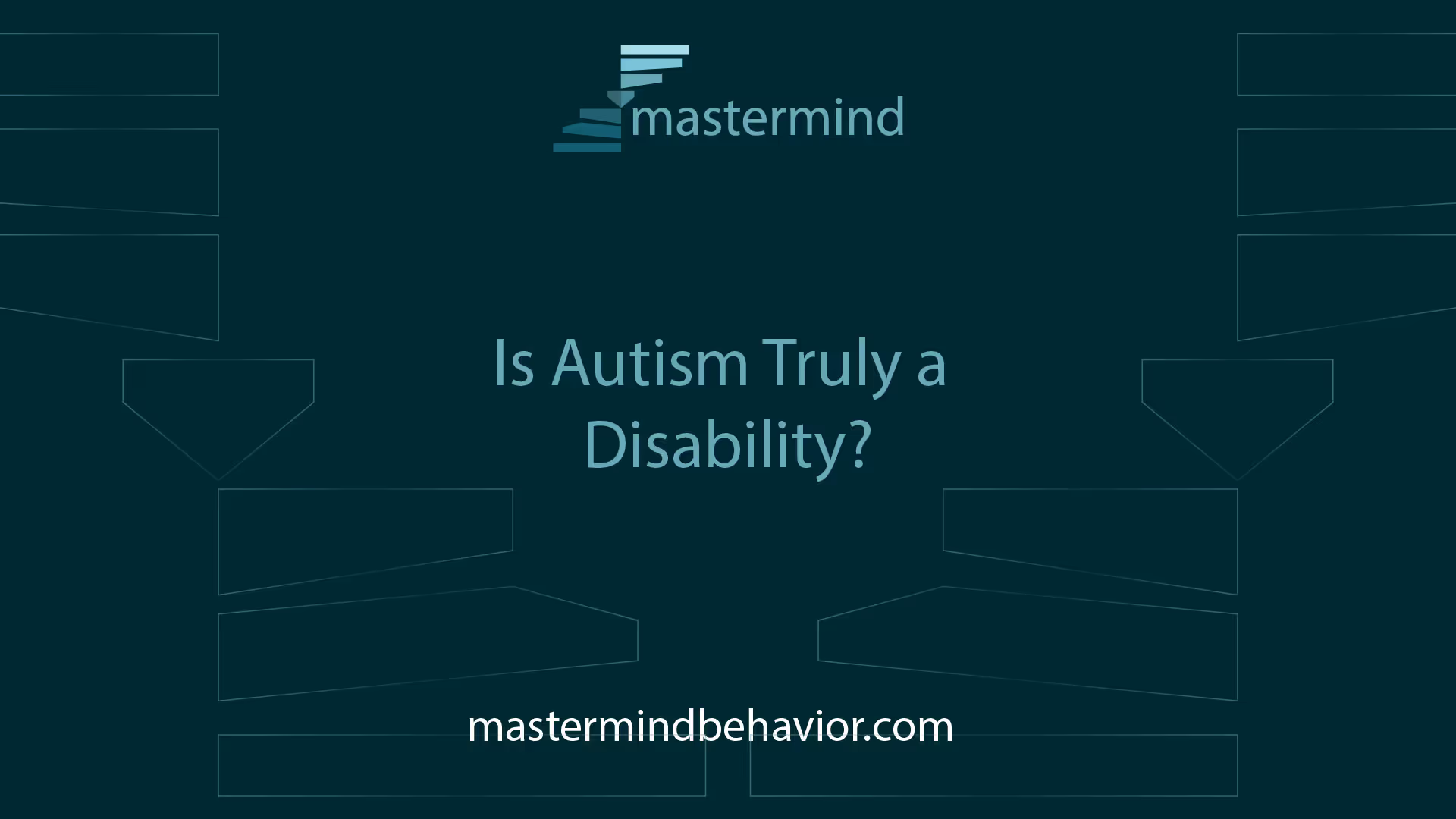Is Autism Truly a Disability?


Understanding Autism Spectrum Disorder (ASD)
Definition and Impact
Autism Spectrum Disorder (ASD) is a complex condition that affects how individuals interact with others, communicate, learn, and behave. Symptoms of ASD typically appear within the first two years of life and can vary significantly in type and severity across the spectrum. This condition is known as a “spectrum” disorder because it encompasses a wide range of symptoms and challenges that individuals may experience [1].
As a lifelong disorder, ASD impacts daily functioning, but effective treatments and services can significantly improve symptoms and enhance quality of life. People of all genders, races, ethnicities, and socioeconomic backgrounds may receive a diagnosis of ASD, highlighting the disorder's broad reach.
Diagnosis and Early Intervention
Diagnosing ASD involves a comprehensive evaluation of an individual's behavior and development, which health care providers can usually conduct reliably by age 2. Early diagnosis is crucial as it enables timely interventions that can lead to better outcomes. Initiating treatments promptly can support individuals in building on their strengths and learning new skills [1].
Individuals diagnosed with ASD may receive referrals to specialists who focus on behavioral, psychological, educational, and skill-building interventions. These programs are often intensive and structured, sometimes involving input from caregivers, family members, and siblings to ensure comprehensive support.
For individuals living in New Jersey, various resources are available that cater specifically to those with autism. To learn more about local support, consider visiting New Jersey Autism Resources. Understanding the importance of early intervention not only helps individuals manage their symptoms but also enhances their overall development and integration into society. For more information on autism prevalence in the region, check out autism prevalence increases in new jersey.
Legal Rights and Support for Individuals with ASD
Understanding the legal rights and support systems available to individuals with Autism Spectrum Disorder (ASD) is crucial for fostering an inclusive environment. Two significant legislative frameworks that provide these protections are the Americans with Disabilities Act (ADA) and the Rehabilitation Act, including the Fair Housing Act.
Americans with Disabilities Act (ADA)
The Americans with Disabilities Act (ADA) is a pivotal federal civil rights law aimed at preventing discrimination against individuals with disabilities. This law guarantees equal opportunities for people with disabilities across various aspects of daily life, which includes employment, public services, and access to public accommodations [2].
The ADA is structured into several titles:
The ADA's Olmstead Decision, established by the U.S. Supreme Court in 1999, reinforces that unjustified segregation of people with disabilities is discriminatory, thereby mandating community-based services when suitable [3].
Rehabilitation Act and Fair Housing Act
The Rehabilitation Act of 1973 is another essential piece of legislation that prohibits discrimination against individuals with disabilities in federal programs and activities. Specifically, Section 504 of this Act protects qualified individuals with disabilities from discrimination in federal government services, programs, and activities, including education and healthcare.
The Fair Housing Act complements these protections by prohibiting discrimination based on handicap (disability) in housing. This ensures that individuals with autism can access housing without facing discrimination. It establishes that individuals with disabilities must have equal opportunity to use and enjoy housing, which includes reasonable accommodations for their needs.
These legal frameworks are integral for individuals with ASD, ensuring that they have equal access and opportunities in various spheres of life. For further insight into autism laws and policies, readers can explore our article on autism laws and policies. Additionally, those looking for resources in their local community should check our guide on New Jersey autism resources. Understanding rights and available support services can empower individuals and their families in navigating life with autism effectively.
Is Autism Considered a Disability?
Understanding whether autism is considered a disability involves examining different frameworks of disability. The two main models are the medical model and the social model, each providing a unique perspective on autism.
Medical Model of Disability
The medical model views disability primarily as a health condition that requires diagnosis and treatment. According to this perspective, individuals with Autism Spectrum Disorder (ASD) have impairments that affect their functioning in various areas of life. The Americans with Disabilities Act (ADA) defines a person with a disability as someone with a physical or mental impairment that substantially limits one or more major life activities. This includes individuals diagnosed with ASD [3].
Under this model, autism is considered a disability due to the challenges it presents in areas such as communication, social interaction, and adaptability. Factors like these can significantly impact daily living and create obstacles in educational and employment settings. The emphasis is on providing interventions and support to help individuals overcome these challenges. You can read more about the laws surrounding autism in our article on autism laws and policies.
Social Model of Disability
In contrast, the social model emphasizes that disability is not just a result of one's impairments but also how society is structured. This perspective argues that it is the barriers created by society — such as lack of accessibility, discrimination, and social stigma — that disable individuals with autism. The social model promotes the idea that society must adapt and remove barriers to accommodate individuals with disabilities, including those with ASD.
In this view, labeling autism solely as a disability may overlook the strengths and abilities of individuals on the spectrum. Instead, this model advocates for societal changes that support inclusivity and respect for neurodiversity. It calls for a transformation in policies and spaces, ranging from schools to workplaces, to understand and embrace the unique contributions of people with autism.
These divergent models provide insights into the nuanced conversation about autism as a disability. Understanding both frameworks is essential for effective advocacy and support for individuals with autism, particularly those living in places like New Jersey, where resources and awareness are continuously evolving. For ongoing support and local initiatives, please visit our resource page on new jersey autism resources.
Challenges Faced by Individuals with Autism
Individuals with Autism Spectrum Disorder (ASD) face unique challenges that can impact their daily lives. This section explores the common difficulties related to social interaction and communication that many individuals with autism encounter.
Social Interaction Difficulties
Social interaction difficulties are a hallmark of ASD. Individuals with autism often struggle with various aspects of socialization, making it challenging to form and maintain friendships. They may have difficulties initiating and sustaining conversations and engaging in imaginative play or group activities. A lack of understanding of social cues can further complicate their interactions with peers.
Common challenges faced include:
Such difficulties may also stem from a struggle with empathy, as individuals with ASD may not fully grasp the feelings of those around them. They often display repetitive behaviors and develop intense interests that may limit their social interactions if not aligned with the interests of their peers KU Online.
Communication Challenges
Individuals with ASD often experience significant communication challenges. This includes both verbal and nonverbal communication skills, affecting their ability to effectively convey their thoughts, feelings, and needs.
Key issues related to communication include:
While autism is not a mental illness and does not need a "cure," appropriate support and interventions can greatly enhance the quality of life for autistic individuals. The focus of treatment should center on developing healthy coping mechanisms and communication skills rather than forcing autistic individuals to conform to neurotypical standards Verywell Mind. For tailored resources, individuals in New Jersey can explore available New Jersey autism resources.
Treatment and Support for Autism
Effective treatment and support for individuals with Autism Spectrum Disorder (ASD) are critical to enhancing their quality of life. Early intervention and specialized programs can significantly impact an individual's development and overall outcomes.
Behavioral and Educational Interventions
Multiple types of behavioral and educational interventions have been developed to assist individuals with ASD. These programs often focus on improving communication, social skills, and daily living abilities. Health care providers who specialize in providing these interventions usually conduct thorough evaluations to understand the unique needs of each individual.
One widely recognized approach is Applied Behavior Analysis (ABA), which uses positive reinforcement to encourage desirable behaviors while decreasing unwanted ones. This method is supported by various studies indicating its effectiveness in improving communication and social interactions among children with ASD.
These programs often involve caregivers and family members, ensuring a supportive environment that reinforces learning and development NIMH.
Importance of Early Treatment
The significance of early diagnosis and treatment cannot be overstated. Health care providers usually diagnose ASD by evaluating a person's behavior and development, typically by age 2. Prompt intervention can drastically improve life outcomes. Research suggests that the sooner ASD is diagnosed and addressed, the more effective the treatments can be NIMH.
Early treatment options include medication and a variety of behavioral, psychological, and educational interventions that are tailored to each individual. Evidence indicates that starting treatment as early as possible can reduce difficulties, help individuals build on their strengths, and promote the learning of new skills NIMH.
In New Jersey, access to resources and programs related to autism can help ensure that individuals receive the necessary support. For further information, individuals and families can refer to New Jersey autism resources to find programs suited to their needs.
Early intervention and intensive support can lead to significant improvements in the skills and outcomes for individuals with autism, highlighting the critical importance of timely and effective treatment options Autism Speaks.
Life Expectancy and Comorbid Conditions in Autism
Understanding the factors that contribute to life expectancy and the medical challenges faced by individuals with Autism Spectrum Disorder (ASD) is crucial for those impacted by autism.
Factors Affecting Life Expectancy
Research indicates that autistic individuals generally have lower life expectancies than the general population. The average life expectancy for people with autism ranges from 39.5 years to 58 years, compared to the global average of approximately 72 years as of 2022 [4]. Several factors contribute to this disparity:
- Chronic Stress: Autistic individuals often face chronic stress due to societal challenges, impacting their overall health.
- Support Needs: Those who require higher levels of support have a significantly shorter life expectancy. There is nearly a 20-year difference in average life expectancy between those needing ongoing assistance and those who can manage independently [4].
- Health Support: Access to appropriate healthcare and support services can influence life expectancy. Autistic individuals receiving adequate support tend to exhibit lower stress levels and a decreased risk of stress-related and mental health illnesses.
Medical Challenges and Support
Autistic individuals are at a heightened risk for various comorbid medical conditions. Some common comorbidities include:
The increased risk for these conditions, particularly mental health issues and the associated risk of suicide, highlights the necessity for comprehensive support systems [4].
Support resources are vital for improving outcomes. Individuals with autism who receive tailored care can experience reduced stress and lower instances of premature death. Identifying appropriate coping mechanisms and treatments is essential for addressing the lower life expectancy associated with autism. For information on available assistance in your area, explore our page on New Jersey autism resources.
References
[1]: https://www.nimh.nih.gov/health/topics/autism-spectrum-disorders-asd
[2]: https://www.ada.gov/topics/intro-to-ada/
[3]: https://autismsociety.org/resources/legal/
[4]: https://www.verywellmind.com/what-to-know-about-autism-and-lower-life-expectancy-6748941
Recent articles

Teaching Time Management Skills to Adolescents with Autism
Building Foundations for Success: Enhancing Time Skills in Adolescents with Autism

How to Support Children with Autism During Changes in Routine
Supporting Autistic Children Through Routine Transitions

How to Introduce Chores to Teach Responsibility in Children with Autism
Building Life Skills Through Household Tasks

How ABA Therapy Encourages Self-Monitoring and Self-Correction
Fostering Self-Regulation Through Evidence-Based Strategies

The role of observation in assessing behavior
Unlocking Behavioral Insights through Observation

The Benefits of Family-Centered Therapy for Autism Treatment
Empowering Families: Transformative Approaches to Autism Care


